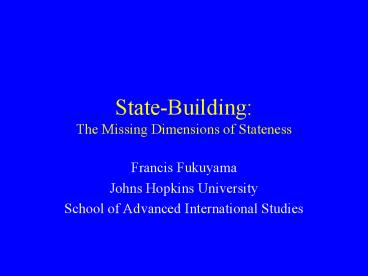StateBuilding: The Missing Dimensions of Stateness - PowerPoint PPT Presentation
1 / 21
Title:
StateBuilding: The Missing Dimensions of Stateness
Description:
Strength of State Institutions. State Capacity. Stateness and Efficiency. Scope of State Functions ... Strength of State Institutions. Quadrant I. Quadrant II ... – PowerPoint PPT presentation
Number of Views:188
Avg rating:3.0/5.0
Title: StateBuilding: The Missing Dimensions of Stateness
1
State-BuildingThe Missing Dimensions of
Stateness
- Francis Fukuyama
- Johns Hopkins University
- School of Advanced International Studies
2
Functions of the State
Source World Bank, World Development Report, 1997
3
The Scope of State Functions
Addressing externalities Education,
environmentRegulating MonopolyOvercoming
imperfect education Insurance, financial
regulationSocial Insurance
Providing pure public goods Defense, Law and
order Property rights Macroeconomic
management Public healthImproving equity
Protecting the poor
Intermediate Functions
Industrial policyWealth redistribution
Minimal Functions
Activist Functions
X-axis
4
Two Dimensions of Stateness
Strength of State Institutions
Scope of State Functions
5
State Capacity
6
Stateness and Efficiency
Quadrant I
Quadrant II
Strength of State Institutions
Quadrant III
Quadrant IV
Scope of State Functions
7
The Stateness Matrix
France
Japan
United States
Strength of State Institutions
USSR
Turkey
Brazil
Sierra Leone
Scope of State Functions
8
Change over Time
Japan 1980
New Zealand 1995
USSR 1980
Japan 2001
Strength of State Institutions
New Zealand 1981
Russia 2000
Scope of State Functions
9
Reform Paths
Path I
Path IV
Strength of State Institutions
Path III
Path II
Scope of State Functions
10
Tax Extraction Rates v. Per Capita GDP
11
Components of Institutional Capacity
12
Weak States and the Black Hole of Public
Administration
- Central issue of all organizational theory is
delegated discretion - Underlying issue in socialism debate (Hayek),
corporate structure (Chandler), federalism - Contemporary approach brings this under a
principal-agent framework
13
Principal-Agent Theory
- Coase, theory of the firm 1937
- Alchian and Demsetz, firms as nexus of contracts
1972 - Williamson, opportunism and bounded rationality
- Jensen and Meckling, agency costs 1976
- Fama, markets for managers 1980
14
Domains of Organizational Uncertainty
- Ambiguity of goals
- Impossibility of erecting formal system of
monitoring and incentives - Inability to determine appropriate degree of
delegation ex ante
15
Public Sector Outputs
Quadrant I
Quadrant II
Low Specificity High
Quadrant III
Quadrant IV
Low Transaction volume
High
16
Monitorability of Public Sector Outputs
Aircraft maintenance
Telecoms
Central banking
Railroads
Highway maintenance
Low Specificity High
Foreign affairs
Court systems
Primary school teaching
University education
Preventative medicine
Guidance counseling
Low Transaction volume
High
17
Consequences of Organizational Ambiguity
- Need to understand better where different public
sector activities fall in the matrix - Seek to fix problems that are actually solvable
- New approaches to activities for which there are
no best practices - Need to teach development differently
18
What follows if public administration is not a
science?
- Need for metis (Scott)
- Does not necessarily imply leaving local
institutions in place - Requires rather contextual judgment about
applicability of foreign models - Need to think about the structure of
decision-making rather than content of decisions
19
Applications
- Japan MacArthurs decision to keep the Emperor
- versus the clean break in Germany
- Iraq disbanding the Iraqi Army
- Iraq tribalism in the Sunni triangle
20
Making Things Worse
- IFIs and donor community complicit in destruction
of institutional capacity - Contradiction between objectives of
capacity-building and provision of services - Need to rethink aims and emphasis of Phase II
nation-building
21
Implications for Democracy Promotion
- Need to rethink 1990s emphasis on civil society
- Good theory but questionable allocation of
resources - Need to deal first with problem of weak states
- Party-building ahead of civil society promotion































